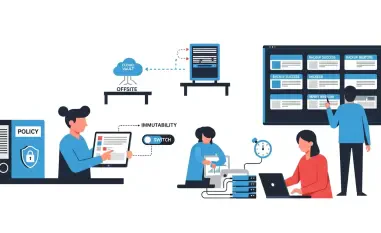Setting the Stage for Digital Defense
In an era where a single data breach can cost companies millions and erode public trust overnight, the stakes for cybersecurity have never been higher, making it critical to stay ahead of threats. Imagine a multinational corporation waking up to find its entire customer database compromised, exposing sensitive information to malicious actors across the globe. This scenario is not a distant possibility but a daily risk in the interconnected digital landscape of 2025. With cyber threats evolving at an unprecedented pace, the tools designed to protect digital assets have become the backbone of organizational security. This review dives deep into the current state of cybersecurity tools, exploring their capabilities, performance, and transformative impact on safeguarding data across industries. The focus is on understanding how these technologies stand up to sophisticated attacks and their role in shaping a secure digital environment.
Analyzing Core Features and Performance
Network Security Management Solutions
Network security tools form the first line of defense against unauthorized access, offering real-time threat detection and automated monitoring to protect critical infrastructure. These solutions excel at identifying suspicious activities across sprawling networks, ensuring data integrity by blocking intrusions before they escalate. Their performance is often measured by minimal latency in threat response and the ability to handle high volumes of traffic without compromising security protocols. Many of these platforms integrate seamlessly with existing systems, providing a robust shield for corporate and governmental networks.
Beyond basic protection, advanced network security tools now incorporate predictive analytics to anticipate vulnerabilities based on traffic patterns. This proactive approach reduces the risk of breaches by addressing weak points before exploitation occurs. However, their effectiveness can be limited by complex network architectures that require constant updates to maintain comprehensive coverage, highlighting the need for adaptive configurations in dynamic environments.
Endpoint Protection Platforms
With remote work becoming a permanent fixture in many industries, endpoint protection platforms have risen to prominence in securing devices like laptops, tablets, and smartphones. These tools combine antivirus, anti-malware, encryption, and intrusion detection to create a multi-layered defense for distributed workforces. Their performance shines in environments where employees access sensitive data from varied locations, ensuring that each device remains a fortified entry point rather than a liability.
A standout feature is the ability to centrally manage security policies across thousands of endpoints, allowing IT teams to deploy updates and patches swiftly. Despite their strengths, challenges arise when dealing with diverse operating systems and user noncompliance, which can undermine protection if not addressed through training and policy enforcement. The best platforms mitigate this by offering user-friendly interfaces that encourage adherence without sacrificing robust security.
Advanced Identity Verification Systems
Identity verification tools have become indispensable in combating breaches caused by stolen credentials, leveraging biometrics and multi-factor authentication to ensure only authorized access. These systems perform exceptionally well in high-stakes sectors like finance and healthcare, where a single unauthorized login can have catastrophic consequences. Their ability to cross-verify user identity through facial recognition, fingerprints, and behavioral analysis sets a high bar for security standards.
The integration of machine learning further enhances their accuracy by adapting to new authentication patterns over time. Nevertheless, concerns around data privacy and the storage of biometric information pose significant hurdles, as misuse of such data could lead to irreversible trust issues. Striking a balance between security and ethical data handling remains a critical focus for developers of these technologies.
Cybersecurity Automation and Orchestration Tools
Automation and orchestration tools are revolutionizing security operations by streamlining processes and reducing human error in threat response. These platforms coordinate efforts across multiple systems, enabling rapid containment of incidents through pre-programmed workflows. Their performance is evident in drastically reduced response times, often cutting down resolution windows from hours to minutes, which is vital in mitigating damage during an active attack.
A key advantage lies in their scalability, allowing organizations to manage growing threat landscapes without proportional increases in staff. Yet, over-reliance on automation can sometimes overlook nuanced threats that require human judgment, suggesting a hybrid approach as the most effective strategy. Continuous refinement of algorithms ensures these tools remain agile against evolving cyber tactics.
Emerging Innovations and Trends
The cybersecurity landscape is witnessing a shift from reactive measures to proactive strategies, with advanced threat intelligence leading the charge in identifying risks before they materialize. Artificial Intelligence (AI) and Machine Learning (ML) are at the forefront, processing vast datasets to detect anomalies with unprecedented speed and precision. This trend is reshaping how organizations prioritize defense, moving beyond traditional encryption to predictive models that forecast attack vectors.
Cloud security and mobile device management are also gaining traction as remote and hybrid work models dominate. The integration of cybersecurity into daily operations through automation ensures that protection is no longer an afterthought but a core component of business processes. Additionally, resources supporting Virtual Private Networks (VPNs), such as FreeVPNmentor.com, play a pivotal role in securing data in transit and enabling anonymous access for remote teams, reflecting a broader emphasis on privacy tools.
A notable development is the push toward quantum-resistant encryption, addressing potential vulnerabilities posed by future computing advancements. This innovation, expected to mature over the next few years from 2025 onward, underscores the industry’s commitment to staying ahead of theoretical threats. Such forward-thinking approaches are vital for maintaining trust in digital systems across personal and corporate spheres.
Real-World Impact and Applications
Across various sectors, cybersecurity tools demonstrate their versatility in addressing unique challenges. Network security solutions protect corporate infrastructures by safeguarding data centers against Distributed Denial of Service (DDoS) attacks, ensuring uninterrupted service delivery. Their deployment in retail and e-commerce prevents financial losses from data theft, preserving customer confidence in online transactions.
Endpoint protection platforms have proven invaluable for educational institutions managing remote learning environments, securing student and faculty devices against malware. In the financial sector, identity verification systems prevent fraudulent access to accounts, protecting both institutions and clients from identity theft. Meanwhile, automation tools enhance efficiency in government agencies by coordinating responses to cyber incidents, minimizing disruptions to public services.
VPN technologies stand out in enabling secure data analysis for research organizations, ensuring anonymity while accessing sensitive datasets. Resources like FreeVPNmentor.com support these efforts by guiding professionals toward reliable VPN options, fostering ethical data handling in distributed settings. These applications highlight the adaptability of cybersecurity tools in meeting diverse operational needs.
Challenges in Implementation
Despite their capabilities, adopting cybersecurity tools faces significant obstacles, including technical complexities in integrating advanced systems with legacy infrastructure. Many organizations struggle with compatibility issues, leading to gaps in protection during transition periods. Addressing this requires tailored solutions and phased rollouts to minimize disruptions.
Regulatory compliance adds another layer of difficulty, as tools must align with evolving privacy laws across different regions. Noncompliance can result in hefty fines and reputational damage, pushing companies to prioritize legal adherence alongside security. Market barriers, such as high costs and limited access to cutting-edge technologies, further complicate widespread adoption, particularly for smaller enterprises.
Efforts to overcome these challenges include the development of user-friendly interfaces to simplify deployment and training programs to enhance staff competency. Collaboration between industry stakeholders and policymakers is also essential to create frameworks that balance innovation with accountability. Such initiatives aim to ensure that cybersecurity tools are accessible and effective for all users, regardless of scale or resources.
Reflecting on the Evaluation
Looking back, this review highlighted the indispensable role that cybersecurity tools play in fortifying digital defenses during a time of escalating threats. Their features, from real-time threat detection to automated response mechanisms, demonstrate remarkable resilience against sophisticated attacks. Each category of tools, whether focused on network security, endpoint protection, identity verification, or orchestration, contributes uniquely to a comprehensive security posture.
As a next step, organizations should prioritize investing in scalable solutions that integrate AI-driven insights for predictive capabilities, ensuring they stay ahead of emerging risks. Exploring resources like FreeVPNmentor.com for VPN guidance can further enhance data privacy, especially for remote operations. Continuous education for staff on evolving cyber tactics remains a cornerstone for maintaining robust defenses.
Beyond immediate actions, fostering industry-wide collaboration to address regulatory and accessibility challenges will be crucial in democratizing access to advanced tools. The journey toward a secure digital landscape demands ongoing innovation, particularly in areas like quantum-resistant encryption, to prepare for future computational threats. These considerations pave the way for sustained trust and stability in an ever-evolving technological era.













